
Poker is a game of chance where the outcome of a hand depends on the cards that have been dealt. It is a gambling game that requires skill and psychology, as well as luck, to play effectively.
The basic rules of poker are simple: Players ante an amount, then place bets into a central pot. The highest hand that does not fold wins the pot.
A player’s starting hand consists of two cards face up and one card face down. The dealer deals the cards to the players in clockwise order, starting with the player on the left of the button (called the “dealer”) and proceeding clockwise until everyone has two cards.
Once all the players have two cards, betting begins in a round that typically lasts for several rounds. At the end of each round, all bets are collected and accumulated into the pot.
Players can call or raise the bets they receive during a round of betting, which involves placing a bet that is equal to the original bet. In addition, they can fold, or make no bet at all.
Betting is a critical aspect of poker, and it can significantly affect the outcome of any given hand. In addition to deciding how much to bet, players also consider the cards they are holding, the action of other players, and the strength of their hand.
A player’s initial bets are called antes, and they are required by most games before any cards are dealt. In addition, players may be required to post a small or big blind bet. These are forced bets that give players a little something to chase, but which still leave them at the mercy of the other players’ actions.
The first betting round starts with the player on the left of the dealer and goes clockwise until all the players have two cards. The flop is then dealt, and players can use their cards to create a better hand.
If more than five players are playing, fewer than five cards are dealt, and the final showdown is usually held between those with the best hands. The winner is the player with the highest five-card hand.
Some of the most common types of hands in poker are high cards, pairs, and three of a kind. A high card is a single card, such as an ace. A pair is two cards of the same rank, such as a pair of aces. A three of a kind is three cards of the same rank, along with two other unrelated side cards.
Other types of hands are flushes and straights. Flushes are hands in which all the cards are of the same suit, such as J-8-5-3-2. Straights are a run of consecutive cards, such as Q-J-Q-K-J.
In poker, pairs and three of a kind are considered strong hands. A pocket king or queen can be very strong, as can any pocket pair. However, it is important to note that the ace on the flop can spell disaster for any pocket pair.